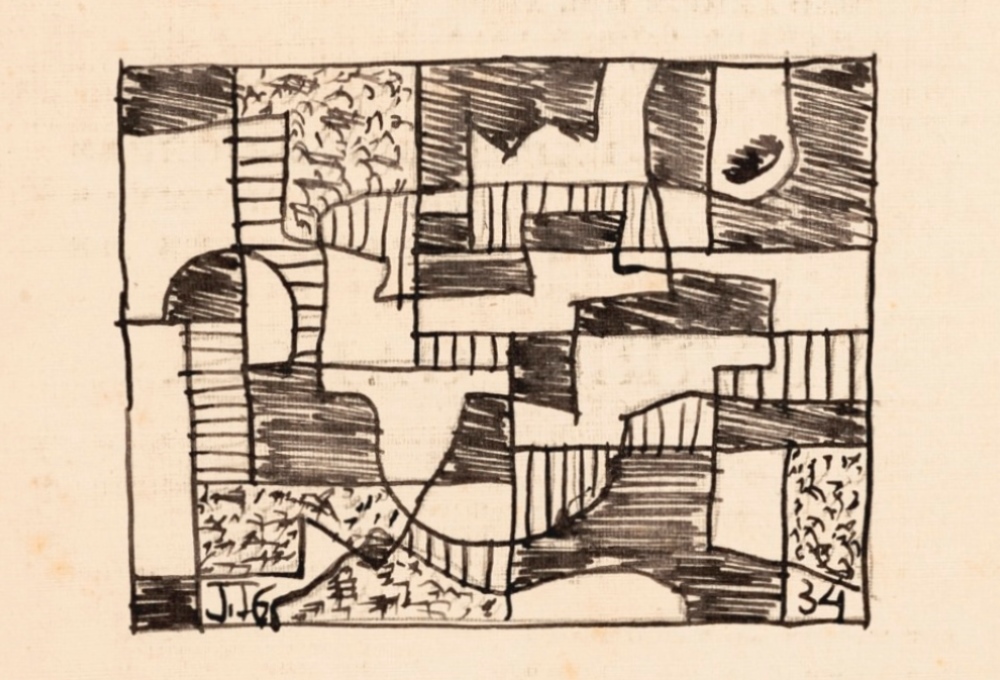Drawing on paper by Joaquin Torres Garcia – Titled: Estructura, 1934
Original drawing by Joaquin Torres Garcia – Titled: Estructura, 1934
Ink and pencil on paper monogramed on lower left and dated on lower right.
Dimensions: 11.5 x 14.5 cm – 4.5 x 5.7 in
Provenance: Gallery M.H, Paris
Price: *CAD (Canadian dollar) For price, shipping and details or more information on the artist contact the gallery.
Clic here to see more artworks on paper >>
Joaquin TORRES GARCIA (1874 – 1949)
Joaquín Torres-García was born on July, 28 1874 and died onAugust, 8, 1949. He was a Uruguayan-Spanish artist who was born in Montevideo, Uruguay. Torres-García emigrated to Catalunya, Spain as an adolescent, where he began his career as an artist in 1891. For the next three decades, Torres-García embraced the Catalan identity and led the cultural scene in Barcelona and Europe. As a painter, sculptor, muralist, novelist, writer, teacher, and theorist, Torres-García was considered a “renaissance” or “universal man.” He used a simple metaphor to deal with eternal struggles he faced between the old and the new, between classical and avant-garde, between reason and feeling, and between figuration and abstraction: there is no contradiction or incompatibility.
Like Goethe, Torres-García sought to integrate classicism and modernity. Although he lived and worked primarily in Spain, Torres-García was also active in the United States, Italy, France, and Uruguay; he influenced European and North American and South American modern art.
Torres-García is known for his 1903 collaboration with Antoni Gaudí on the stained-glass windows for the Palma Cathedral and the Sagrada Família. He decorated the medieval Palau de la Generalitat de Catalunya with monumental frescoes.
His art is associated with archaic universal culture, including Mediterranean cultural traditions, Noucentisme, and modern classicism. Torres-García developed a unique style: He was first known as “Art Constructif” during the 1930s, while he lived in Paris. Arte Constructivo (Constructive Art), a school he opened in Madrid, became Universalismo Constructivo (Universal Constructivism, a treatise he published in South America while teaching in his workshops Asociación de Arte Constructivo and El Taller Torres-García. Torres-García’s art combines classical and archaic traditions with twentieth-century “-isms”: Cubism, Dada, neo-plasticism, primitivism, surrealism, and abstraction.
He founded several art schools in Spain and Montevideo and a number of artistic groups, including the first European abstract-art group. Torres-García founded the magazine Cercle et Carré (Circle and Square) in Paris in 1929.
In the United States, he exhibited in New York during the 1920s as the Whitney Studio Club, the Society of Independent Artists and the Societe Anonyme were emerging. In the 1930s, Albert Eugene Gallatin exhibited Torres-García’s work in the Museum of Living Art with modern masters Picasso, Georges Braque, Henri Matisse and Fernand Léger. The Museum of Modern Art opened its Latin American collection in the 1940s with the acquisition of Torres-García’s work, and the Sidney Janis and Rose Fried galleries sponsored shows during the 1950s. Retrospectives in Paris in 1955 and Amsterdam in 1961 are the earliest shows documenting Torres-García in the world of abstract art.
The Solomon R. Guggenheim Museum had a retrospective exhibition in the 1970s, and more-recent retrospectives at the Museum of Modern Art in 2015 and the Acquavella Galleries in 2018 exhibited Torres-García’s art with a contemporary perspective.
#biography – YLA and Wikipedia
Date:
August 15, 2021
See more artworks and bio of
Drawings